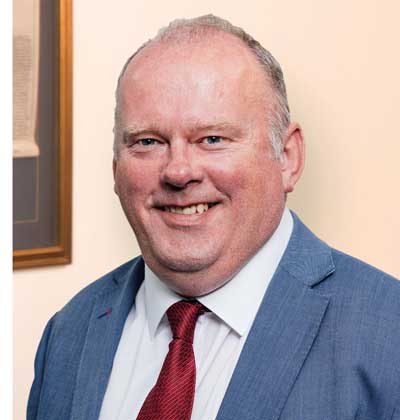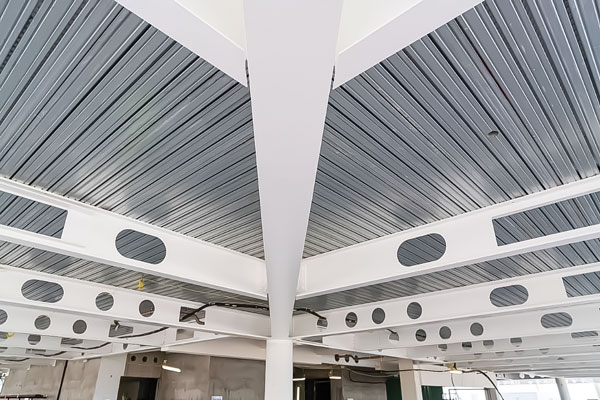News
Letters: April 2005
NSC welcomes letters from readers on steel construction related issues. Please keep your letters brief — the editor reserves the right to condense.
Intumescent quality finish
Having had the opportunity to go around and photograph the Wellcome Trust building, I was particularly interested to read your article (NSC March 2005).
I can attest to the very high standard of the detailing and finish, which is only indirectly referred to in your article. It is sometimes said that the use of an intumescent paint is not conducive to a high standard of finish on the columns. I believe that this building disproves this assertion. The column finish was excellent. I am told that the fact that the circular column hollow sections were filled with unreinforced concrete, allowed the intumescent to be of minimal thickness and to go on in one coat, just like any other paint. That such thin coats can still give a one hour fire rating seems to me of great significance to architects, principally because of the superb finish that can be achieved but also because of the cost savings.
Andrew Calland
School of Engineering, Northumbria University, Newcastle upon Tyne
Lessons to learn from overseas
I read with interest Derek Tordoff’s comments (NSC March 2005) on the worldwide market development activities in steel construction and the consequent decline in the use of concrete. In France we also have a comprehensive market development programme under way for steel construction which is resulting in increased market share against concrete in many sectors including multi-storey buildings and bridges. There is significant growth potential for steel in construction across the whole of Europe. As part of this programme, together with the European Convention for Constructional Steelwork (ECCS), from 20–21 September we will be holding an International Symposium on Architecture and Steel in Nice. Delegates from the UK would be most welcome to attend; the presentations will be given in English. Further details can be found from beginning of April at www.scmf.com.fr
Jean Louis Gauliard
Secrétaire Général du Syndicat de la Construction Métallique de France – SCMF
Concrete fire tests needed
Recent events at the Windsor Building in Madrid are a timely reminder that nothing can be taken for granted. The near collapse of the building in a fire which, although of long duration, did not appear to reach the temperatures under which materials are normally tested, indicates that the margins of error and levels of conservatism under which we often assume we operate may not always be valid. The fire has also shown the importance of getting all fire precautions installed correctly, and how a relatively small error such as the reported absence of fire stopping between the floors can have potentially catastrophic consequences. We have been concerned at this state of affairs in the UK, and it formed a part of the report from a Partners in Innovation project in 2003.
Of even greater importance, however, is the fact that the fire also raises questions about the behaviour of the building frame. This is understood to be reinforced concrete, a material which is believed to behave well in fire. However, I am aware that in recent years troubling questions have been raised as to whether this reputation is fully justified, and a number of fires such as that in Madrid, the Channel Tunnel and others which have led to concrete frame collapses have led to calls for a reappraisal of the situation. In particular, I am now finding widespread agreement that phenomena such as excessive spalling and thermal expansion of floors are causing particular concern and are not sufficiently well understood. For example, any reliance upon “membrane action” is something that requires more understanding.
I would like to add my voice to those who have expressed apprehension and call on the concrete industry to dispel these concerns through a commitment to large scale testing, similar to that carried out by the steel construction sector over the past decade.
David P Sugden
D P Sugden & Associates Ltd
No car park vibration issue
On reading your two articles regarding steel-framed car parks in NSC March 2005, I noticed that the question of vibration was not discussed. Please could you advise me if there are any reference documents regarding this ?
Matt Scolin
Bone Steel Ltd
The Editor replies: The recently issued “Steel-Framed Car Parks“ 3rd edition from Corus Construction & Industrial contains information on dynamic performance in steel-framed car parks. In it advice is given on response factors for car parks and results of a study of nine steel-framed car parks constructed over the last 15 years where no adverse comments about dynamic behaviour had been noted.
This section of the design guide concludes “The study shows that the traditional natural frequency value of 3.0Hz can be maintained for design, and used with confidence“. A copy of this design guide is available from Corus literature hotline on 01724 404400 or via the website www.corusconstruction.com
You may also be happy to hear that a revised and updated edition of the SCI design guide “Design guide on the vibration of floors“ (P076) is planned for later this year. This complements the publication in 2004 of “Design Guide on the vibration of floors in hospital“ (P331) also by the SCI.











